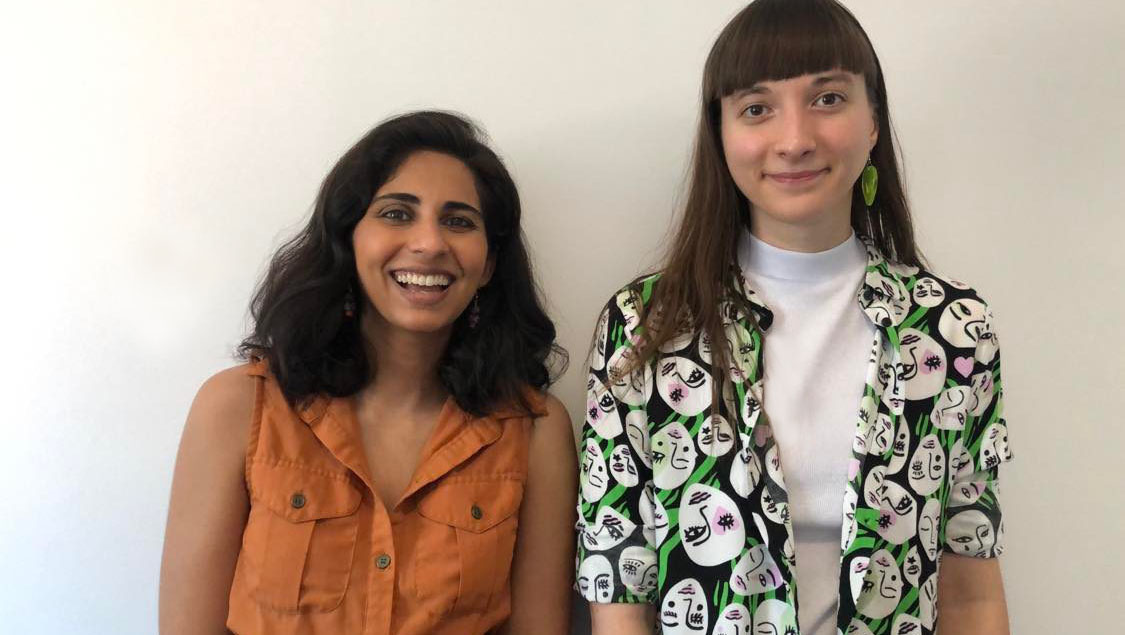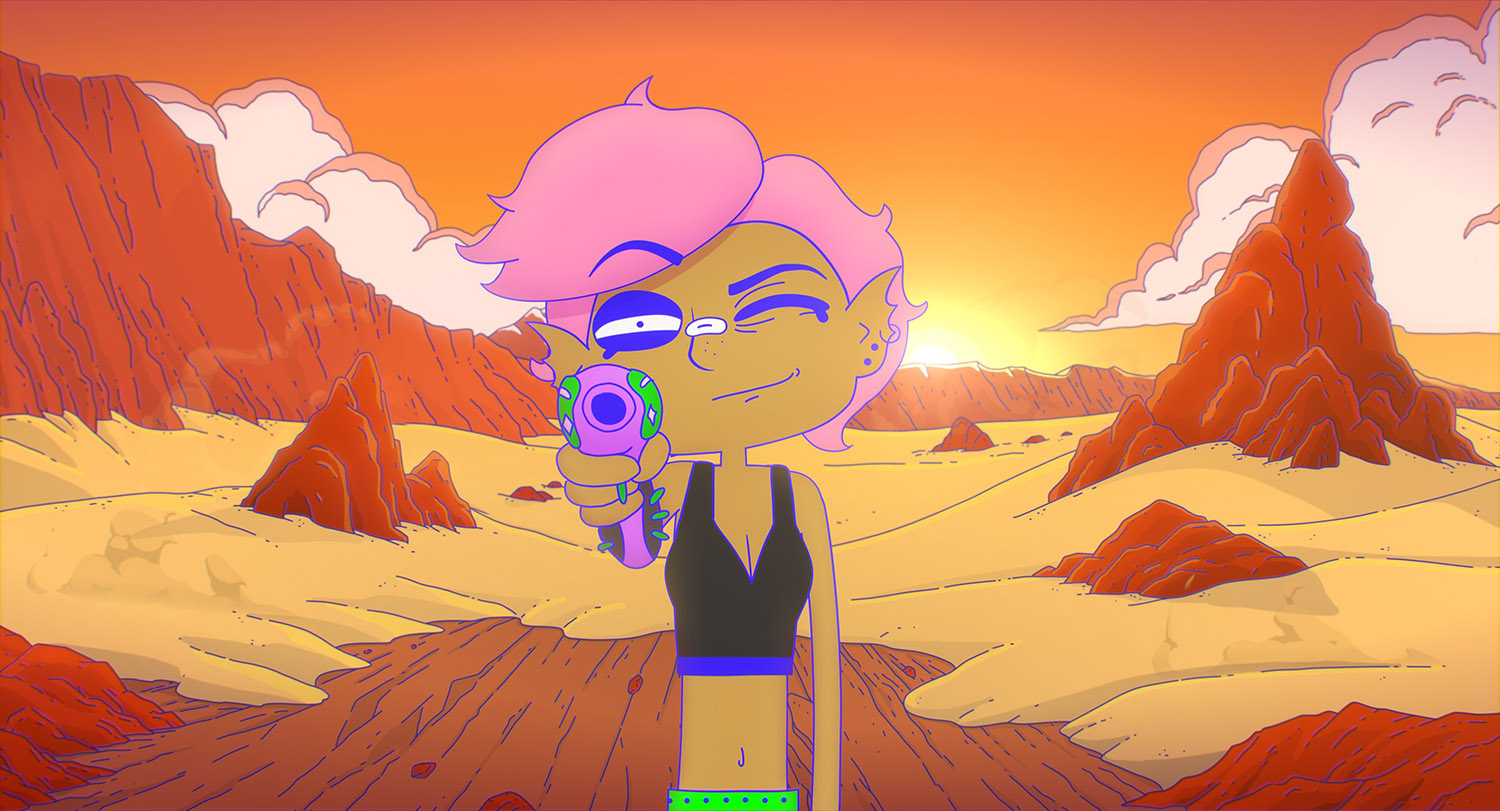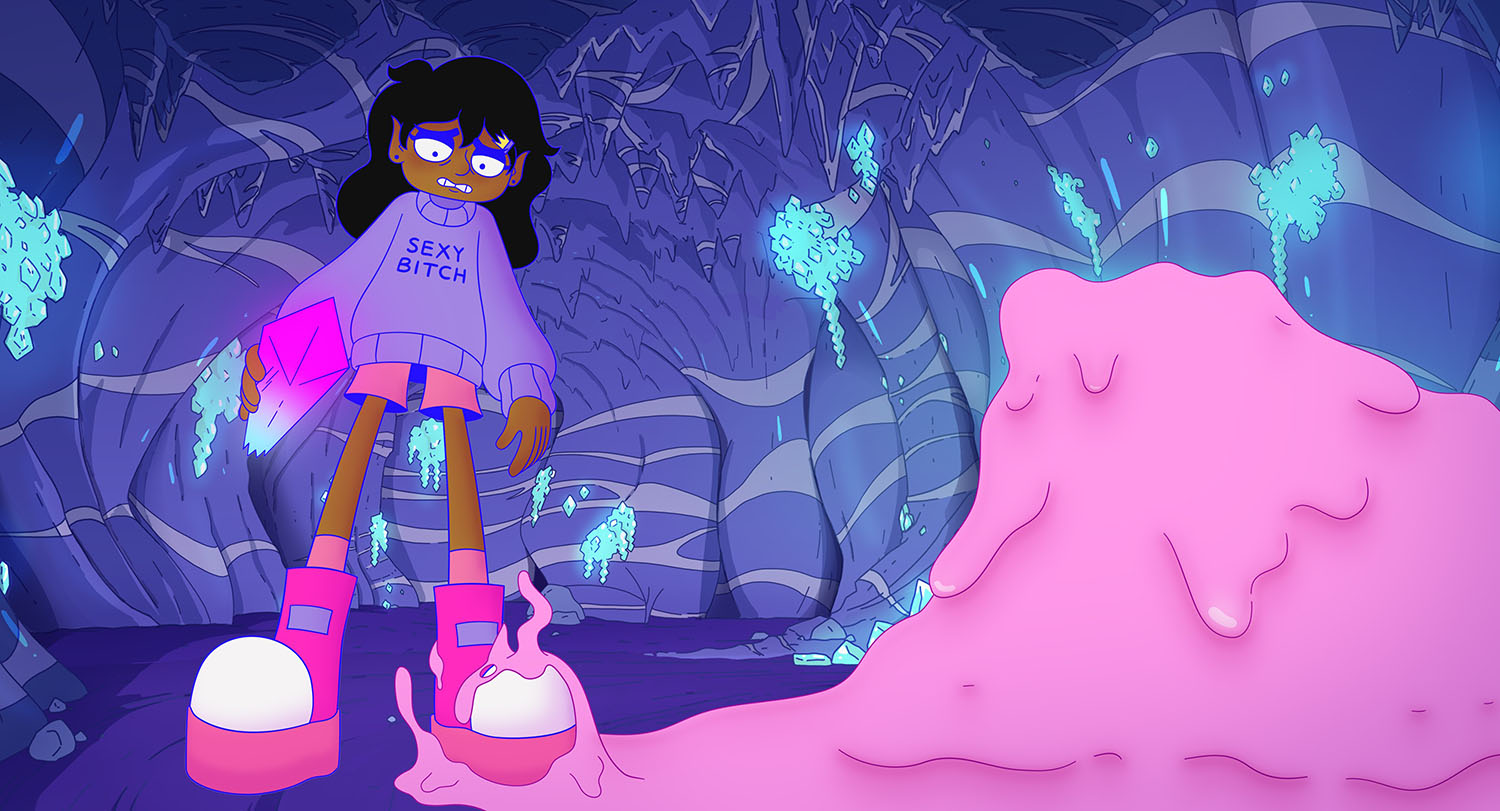[ad_1]
Presented earlier this year at the Berlinale, Lesbian Space Princess enters Australian adult animation history with a bang as the first animated feature to come out of Southern Australia, while providing a welcomed queer addition to the often white and male landscape of adult animation.
The first feature of Aussie duo Emma Hough Hobbs and Leela Varghese, the film focuses on the quirky and shy Princess Saira from Clitopolis, as she embarks on a space odyssey in order to free Kiki, a cool-ass mercenary who also happens to be her ex-girlfriend, from three Straight White Maliens, voiced by popular comedy trio Auntie Donna.
Along the way, Saira will have to leave the comfort of Clitopia’s safety bubble and face a brutal world aboard an old — and mean — macho spaceship, meeting with drag warlords, goth wannabe popstars, and a whole universe of weirdness.
With a micro-budget of just US$600K, the duo and their very small team of six animators managed to create a flamboyant animated comedy with heart, tackling modern topics through adult humor and quirky musical numbers composed by Vargheese.
As Lesbian Space Princess is now on track to hit theaters worldwide with the help of U.K. sales agent Blue Finch Films, Cartoon Brew spoke with the two directors, who radiate the same energy as their project, about their journey as queer filmmakers.
Cartoon Brew: What drove you to become animation filmmakers?
Emma Hough Hobbs: Before this project, I had only created animated short films, and part of this process was about discovering how we could work together, and figuring out what kind of project could emerge from that first collaboration. Obviously I wanted to make animation, and that’s something that Leela took to like a duck to water.
Leela Varghese: I come from live-action comedy, and I’m also a very expressive person, so animation was a good fit for me. Merging our two skillsets, what we had in mind was: how can we make something that feels like the both of us, and that can also elevate both of our careers? And so, this is how the idea was born. We also received support from the Film Lab:New Voices Initiative. As for the title, we struggled a bit, but it eventually came to Emma in the shower.
Hough Hobbs: Yeah, like, appearing through the fog: “Lesbian. Space. Princess!” It was the best shower ever. And then, as I came out with my hair wrapped up in a towel, I was like, “Babe, I got it.”
Varghese: At first, I thought it sounded stupid, and I definitely had to be sold on it. But our producer Tom Phillips from Wemat Studios, who is a straight white male, also got very enthusiastic about it. He was all in, and that’s how we started on the project.

What compelled you to tell this story in the first place?
Varghese: It sort of started with the story focusing more about Kiki as the main character. Could we make a film with a Cowboy Bebop vibe, but from a different perspective? I’m half-Indian, half-Lebanese, and I’m partnering with Emma who is another woman, and we were wondering: could we achieve something like that? And then, it became clear to us that this angle wouldn’t necessarily bring something super fresh, something unique from our perspective. Saira and a lot of characters in the movie are born from ourselves, and our will to represent people like us in the adult animation space, and wanting to represent a slightly different tone of comedy. It was about trying to be true to who we are as creators, and that’s a big part of how and why this story was born.
Hough Hobbs: Many times, when you see anxiety represented in a film or tv show, it’s always seemingly fixed overnight. And I think for us, it was important to show that that’s not what life is like. Our character was going to be consistently anxious, and she was going to win little battles to change for the better.
Varghese: Putting Saira as the main character was less predictable to us, especially with a title such as Lesbian Space Princess. People would maybe expect something a little different, but that was also the point, shifting expectations. We also wanted to build a comedy with heart, tackling themes of relationships and self-love, and learning to be able to like yourself separate from other peoples’ validation. It felt also as a nice and important message to include in this project.
Hough Hobbs: And as queer filmmakers as well as animation enthusiasts, it was important to us to get this story out there. There’s not that many creators that are making content for people that are queer and like animation. For me, this was a big frustration growing up, and so I wanted to make something for all the “little gay nerds” out there, when something like Rick and Morty doesn’t quite cut it.

How did you come up with the visual style of the film? Did you already have your aesthetic in mind when building this story?
Hough Hobbs: The actual character designs were based off stuff I used to do in university for fun. Then the worldbuilding came from the script. Because I got to design the film, I worked very closely with the background artist and animators, and that’s something that we discovered along the way. We worked with a team of mostly women artists, and were able to create an environment where everyone felt safe enough to pitch really fun ideas. Part of this creative process was made of fun discoveries, and the actual style of the film is my own.
Varghese: It’s a great opportunity for Emma to showcase her style, but also at the same time the film is a clever use of her style within the restrictions of our small budget. Choices were made in a very strategic and cost-efficient way, something that you can only do if you’re working with an animator that understands these parameters.
Hough Hobbs: At the end of the day, we wanted it to look as good as it could, but we also knew that we had to create an animated feature with a total budget of $600,000 American dollars within a year. It’s a bit different than, let’s say, Inside Out 2.

Speaking about the team, how did you assemble it and how did you divide the workload between the two of you and this team?
Varghese: With our producer, we always had this little joke that we were creating a little Suicide Squad, because the task of making the film seemed somewhat impossible. But thanks to Emma, who has some sort of sixth sense to know an animator’s ability just by looking at one or two things they’ve done, we assembled our core team — Alice [Lam], Cheyenne [Maher], Anthony [Robinson], Madeleine [Karutz]. And they all exceeded our expectations, especially the two lead animators, Alice and Cheyenne.
Hough Hobbs: They literally blew us away. I genuinely don’t think the film would have been possible without the both of them. We had two full-time animators, two part-time background artists, myself as a lead animator, and then Jeremy [Kelly-Bakker] as the other lead, and that’s the entire team who worked on the film — apart from a few casuals. Alice was insanely fast, like a gazelle flowing in Toon Boom Harmony, which was so much fun because we could just load her up with stuff we thought would be impossible, and she’d be like, “I’m done, what’s next?”
And Cheyenne was really good at the emotional performances, so anytime any of our characters are kind of emoting, or having to deliver a certain performance. All the dialog is basically performed by Cheyenne. Yet with all this workload, a big part of our attention was dedicated to the fact that everyone had to be home by 5pm, except for us and Tom.
Varghese: Exactly. Fostering an environment that was professional and safe, without taking advantage of anyone that wasn’t part of the core team of the project was very important to us, at least for the animators. It was a steadfast rule to us and it helped us create a fun environment. It did end up creating some sort of utopia, and it was so sad when it all ended because we had created a dreamlike place to work, and a caring team. Like a miniature animation family.
New voices in animation cherish this kind of work environment. And your film, along with Flow, proves that it can be done and that it can also lead to great creativity and freedom, so congratulations on that part. Can we follow by going into the music of the film, which plays a great role in Lesbian Space Princess? It’s almost a musical…
Varghese: Our producer would strongly disagree with the term, but the film definitely has a musical element that is tied into the narrative of the story. And it’s something that I love and one of my favorite aspects of the project. I’m a songwriter and I come from musical comedy, and I always wanted a career writing songs. Putting them in the film, we hadn’t figured out at first that they would be linked with Willow’s character, and connecting the two was a real breakthrough. To me, those songs are like Willow’s album that she releases at the end of the movie. It’s not necessarily super obvious within the film, but I love that idea, it brings meaning and works as a little bow to tie the film together.

From a technical standpoint, could you take us through your pipeline, and how you actually built the film?
Hough Hobbs: At this point, we have to underline that, without Jeremy who acted as our technical lead, none of this would have been possible. He made the puppets for when there are puppet shots (yes, there are some puppet shots in the film). I drew and we made the animatic in Premiere Pro and Photoshop, with Leela voicing all the characters.
We edited the animatic in Premiere, and then would chop up the different shots, put them in our database, and Jeremy would sit down and recreate every single one of them in Maya with blocks, so the background artists could get the proportions correctly. It may seem nothing, but when you create feminist animation, people really like to pick apart the technical aspects. I was terrified of people potentially treating us like they treated High Guardian Spice, and so we couldn’t get the backgrounds wrong.
That part was done in Maya, then they screenshot it, worked it in Photoshop, and then these 6k backgrounds went into Toon Boom where animators made a mixture of puppets for the dialog scenes and traditional animation as soon as the characters moved around. All this work was then composited by Jeremy, then imported into Nuke for some particular shots, then a few others were run through After Effects if it made sense, and all would go back into DaVinci Resolve for the edit. Then a few more loops, and that’s it.
Varghese: That’s the interesting part. Because when we came to the edit phase, we actually ended up doing a whole creative edit pass once we had all the pieces together. That’s when we figured out the pacing for the film, and that was really fun to go through everything and just tighten it to really make it work. Like you would for a live-action film, and it forced us to get creative with the material we had crafted. Ben Fernandez, our editor, ended up calling this “pool of content” his “animation shop.” Of course there was a limit to the amount of stuff that we could get back from that “shop,” but we managed to make great use of it.
Hough Hobbs: At the end of the day, Lesbian Space Princess is very much handmade. It was an exhilarating process, but also we would never do it the same way again!
Adult animation led by female directors is not that common, even less so from Australia. How do you feel bringing this project to life in this global context?
Hough Hobbs: It feels very timely. During production, all the details about Justin Roiland came out, and to me, it added fuel to why it’s important to not have the same people making most of the adult animation and adult animated content over and over. Because that also informs the fanbase, right? As a female girl-nerd, I grew up not feeling safe or comfortable in fandom spaces at conventions. You need to pave space for women and queer people to exist in those areas which are supposed to be fun for everyone. And so far, it’s been a great ride, the making of this project but also the reception of it. The real fun thing about Berlin was just being in big rooms full of people — mostly queer people — just having a great time. It’s restorative, I think.
Varghese: And at the same time, because we’ve been asked this question a lot, it’s not about taking down those men or those creators. We’re not out to get anyone, it’s about the audience, and giving this audience something that was underserved. It’s just about being who you are as a creator, and hoping to help some people feel seen. But it’s interesting because it seems like in order to do that, it always ends up being somehow about the other side feeling that their territory is threatened.
And at the same time, we love our Straight White Maliens, I adore those three characters. What is important for us is that this project is a celebration of what can happen when voices come together. Because this project is literally produced by a straight white man, and he has the love and passion for it. We want to live in a world where people can just come together and make projects that they love, instead of trying to separate them from each other.

Is there an aspect of the film that you want to underline, an important detail to you that is often overlooked?
Hough Hobbs: Did you notice that Saira has five fingers instead of four in the film? Every other character has three fingers and one thumb, but Saira has four. Why? It’s because she’s really good with her hands!
Varghese: And speaking of Saira, we also want to give a shout out to our amazing voice actress Shabana Azeez, one of our friends who’s also been growing out as a professional, and that’s the sort of interpersonal level of building and growing together with the people we started out that I love about the film.
To wrap things up, what would you say would be your very first memory of animated cinema?
Varghese: What comes out of my head straight away is Bambi. I remember feeling so much emotion when watching the film, it was heartbreaking.
Hough Hobbs: I grew up watching those fucked-up Barbie movies, Barbie as Rapunzel and the likes, but the thing that changed everything was Cardcaptor Sakura on VHS. My grandmother brought one home for my brother from a garage sale, and that changed my world. I just became obsessed with anime, and I literally just watched animation until I started studying film.
[ad_2]
Source link



